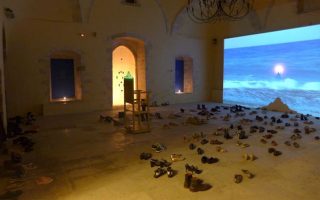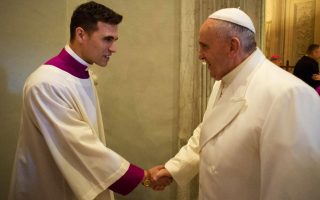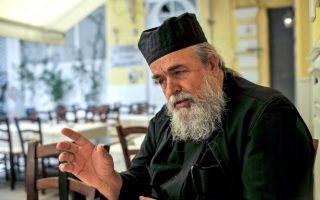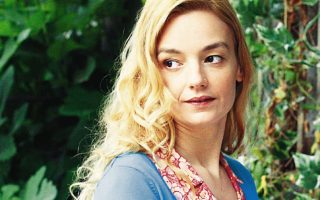Tetsis in the early years: For God and country
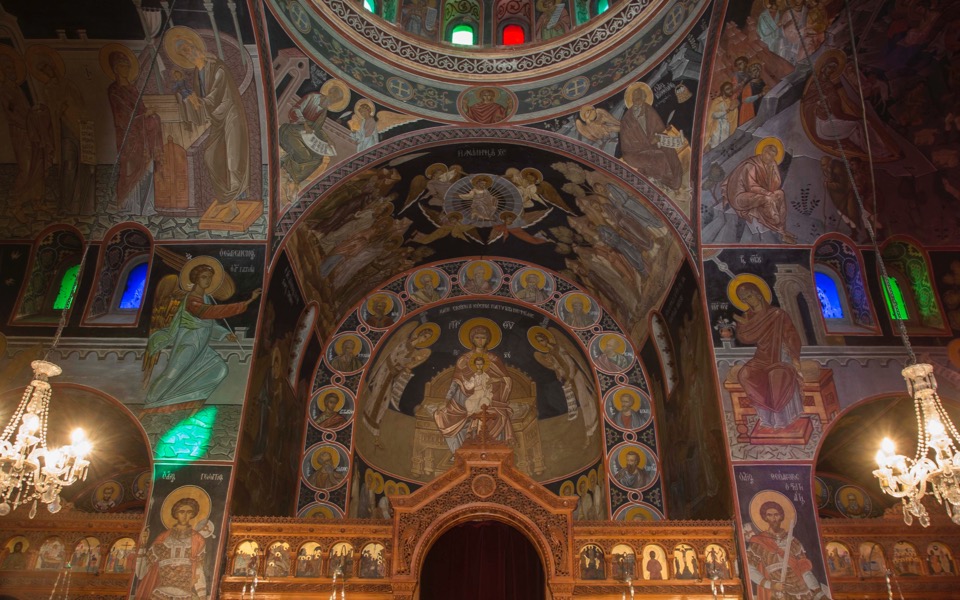
A year after the death of one of Greece’s most prominent artists, Kathimerini offers a glimpse of a monumental project that is almost unknown to the general public, carried out by Panayiotis Tetsis (1925-2016) at the Church of Aghios Dimitrios on the grounds of the Hellenic Navy Academy in Skaramangas, west of Athens, during his military service in 1948 – long before he became a household name as a post-impressionist seascape painter.
As icon painter and Byzantine archaeologist Georgios Tsantilas explains, Tetsis first painted the church’s apse, depicting the Virgin Mary enthroned and holding the Christ Child in her arms, flanked by two angels, as well as the Communion of the Apostles beneath that and the four archangels in the bottom tier of the painting.
The arch of the sanctum shows the Ascension of Christ, with illustrations of the healing of the blind man and the Good Samaritan to either side. The prophets are shown in medallion icons on the archway and again in full at the top of the dome, surrounded by the evangelists on the pendentives.
“He is faithful to the Cretan style, very severe and absolutely linear, following in the footsteps of Photis Kontoglou,” comments the expert.
“There is nothing of what we call artistic license. Even the light cast on the garments is absolutely linear. This work allows us to explore a different side of the artist, which I believe is the source of his art. He made the leap into free painting after first obtaining a strong grasp of Byzantine iconography,” adds Tsantilas, who knew Tetsis personally but is also well acquainted with the artist’s work in iconography.
Tsantilas and a team of associates took on the task of conserving the paintings in the church, without making any interventions in Tetsis’s work, even though he believes they need to undergo preservation. He explains that Tetsis also painted the icons on the templon and is also believed to be behind the stunning depiction of God the Almighty (Pantokrator) on the dome.
What makes this church particularly interesting is that the only other ecclesiastical work that has been attributed to the artist consists of a few portable icons and a series of murals in the Greek Orthodox Church of Aghios Nikolaos (Saint Nicholas) in Rotterdam.
When contacted by Kathimerini, the church’s archpriest, Ioannis Psomas, confirmed that Tetsis executed the murals in the late 1950s while studying in Paris on the recommendation of the Benaki Museum.
The Church of Aghios Dimitrios in Skaramangas was built in 1945-47 and hosts a special annual service commemorating Hellenic Navy casualties. Over the years, however, the elements, and humidity in particular, have caused extensive damage to both the interior and exterior. The damage was repaired recently on the initiative of Rear Admiral Alexandros Diakopoulos, who heads the academy, which helped bring out not just Tetsis’s work but also that of other acclaimed artists who contributed to the artwork in the church while doing their military service.
“The navy acts according to its principles, values and traditions, and this is how we should perceive the work we have here. The Naval Academy is an ark of the corps’ traditions, and in these traditions we also see a cultural legacy,” says Diakopoulos. “These pieces are a part of the artists’ creative evolution even if they were done during their service.”
Unsurprisingly, the theme of the work by the other artists is maritime and includes splendid naval battles painted by the likes of Costas Tsoclis, Christos Carras, Tassos Syntelis and Miltos Pantelias, the latter of whom also depicted scenes from day-to-day life at the academy.
“The subjects were assigned, but I painted in my own style. I was 25 at the time and influenced by my studies in France, so I wanted my work to radiate an internal light, a sense of melancholy,” says Pantelias, who revisited his works 30 years later during their conservation.
Athens University art history professor Manos Stefanidis also served in the navy, but knew nothing of the existence of these works until be was invited to visit the academy by Diakopoulos.
Today he notes that more research needs to be conducted into Tetsis’s pieces in particular to really appreciate their value. “Tetsis made those pieces in the final phase of the Greek Civil War,” says Stefanidis. “Thankfully his art protected him from the horrors of war.”
The art historian also mentions other interesting details he noted during his visit to the academy – which is off-limits to the general public – including the main academy building, which adopts the style of Ernst Ziller, a statue of benefactor Pantazis Vassanis by sculptor Georgios Bonanos, and a series of seascapes by Vassilis Hatzis, among other works by lesser-known artists.
